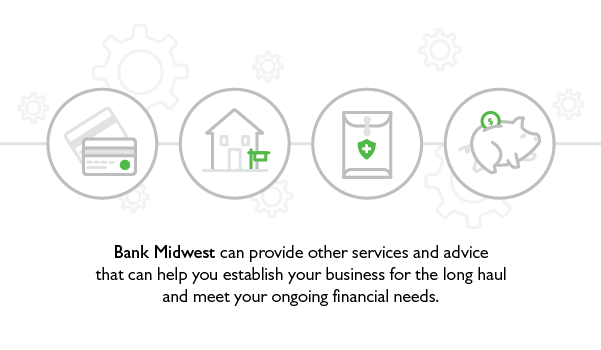Every good company begins with an idea. It could be something you’re passionate about or fill a need in your community. But as romantic a notion as being your own boss is, starting your own business is no small feat. Building your company will take hard work, plenty of time, and a good amount of money.
To grow a healthy business, be sure to start right. You want to set it up for success at every step, from writing a business plan to opening business bank accounts.
There are several steps to creating your business, but we’ve distilled the list down to five of your most important action items to address in the early stages of starting your own business.

Step 1: Draft your business plan
One of the first things you need to do is write down your business plan on paper. Your business plan is like a roadmap that’ll tell you and interested parties (think: investors, lenders, landlords, etc.) how you plan to make money in the first three to five years. It’ll explain the market and what needs you’re fulfilling.
It’s a fundamental step to planning your operations and making a case for your business to financial institutions, which you’ll likely need to work with to fund your idea. Landlords, potential investors, and third-party partners may also read your business plan.
Remember: your business plan requires attention and thought. It’s the foundation of your new enterprise. The more detail and professionalism you can give your business plan, the more persuasive your argument will be to future investors and partners.
Some of the most critical parts of a thorough business plan include:
- An executive summary of your business idea,
- Market research and valuation,
- Description of your products or services,
- Organization and management flowchart,
- Competitor analysis and their market share,
- Branding concept,
- Your marketing plan and what channels you plan to use,
- Funding request, and
- Financial forecasts of how you see your business performing over its first 12 months, second year, third year, etc.
The Small Business Administration has guides to writing your business plan to help you get started. According to their manual, depending on your intended audience, you can choose how you want to present your business plan. You could opt for the following:
- Traditional format: A highly structured document that lays out all the details in a comprehensive fashion. Any lender you work with will likely prefer this type of plan.
- Lean startup format: This is more of a high-level synopsis of your full business plan, containing the most crucial elements. Investors might be more interested in a quick overview of the most salient points.
According to Business News Daily, some commonly overlooked yet highly important aspects of your business plan include:
- The just-in-case plan: Not everything in life, or in business, goes smoothly all of the time, but luckily, you can account for that. Business News Daily suggests having a goal to meet within a specific timeframe, and a backup plan in the event that the goal isn’t met.
- Employee engagement plan: Not all businesses will hire employees right away, but those that do need to make sure everyone hired is as excited as the founders. Working for a brand-new company can feel like a risk for some people, so it’s critical that everyone feel engaged and a part of the team. Spell out exactly how you’ll inspire this feeling in your employees.
- Marketing plan: The one ingredient every single business needs to find success is the right marketing plan. If people don’t know about you, they can’t support your company. Write out what you intend to do to get the word about your business out.
Step 2: Fund your business
The next step to starting your own business is securing seed capital, typically through a business loan or selling an equity stake to investors. While you might have enough financial resources to commit some funding upfront, it’s unlikely you’ll want to sink everything you have into the venture from the outset.
You may use the money you get for real estate, inventory purchases, employee wages, general expenses, and other outflows.
This step is where your business plan comes in handy. You’ll need to present your case to the financial institutions you request funds from, whether your local bank, a credit union or an investor. Your business plan should denote precisely how much you are asking and your plan for managing that debt.
An alternative to traditional forms of financing is the crowdfunding route. Increasingly, more startups are looking to the community to fund their initial operations, promising some return on that investment down the road.
However, small business loans remain the number one source of funding for many entrepreneurs. When talking to prospective lenders, be sure to ask questions about:
- Interest rate.
- Repayment terms.
- Any restrictions on funds.
Read our guide about types of small business loans to learn more about how banks can help your business start strong.
Step 3: Settle your legal obligations
Before you can open your doors, several official approvals and legal requirements must be satisfied. Each type will affect the legal standing of your business name and how you file taxes. For example, you’ll need to determine how you’ll incorporate your business and what structure it will take, either an:
- S-corp (sole proprietorship).
- Partnership.
- Limited liability corporation.
- Corporation.
Once you have your name figured out, it’s time to register it.
Depending on the municipality your operations will reside in, you’ll also need any applicable business licenses. And remember your Employer Identification Number (also called a Federal Tax Identification Number), which is necessary for tax-filing purposes.
Additionally, buy your website domain name as soon as you’ve determined your business name.
Step 4: Get started with business banking
It’s safe to say that you want to start a business to make money. But what will you do with that cash once it starts rolling in?
Before you get a cash register or point-of-sale solution, you’ll need to open up a business banking account to help you manage your finances. Some of the accounts you should include:
- Checking account: A checking account is a primary account that many businesses use to manage money coming in and going out. Your business will have bills and vendor payments to make, and Bank Midwest has three tiers of business checking based on your transaction levels.
- Savings account: Even businesses should put away money for a rainy day. An interest-bearing savings account can put your money to work and earn for your business.
- Merchant account: You’ll need a merchant account to accept credit cards and other forms of customer payments.
- Sweep account: This type of account “sweeps” funds in and out from a primary operating budget automatically, saving you time and earning you interest (or providing you some other benefit).
Step 5: Seek professional guidance
Your core operational team will likely be small during the early stages of your startup. However, your lender may provide other services and advice to help you establish your business for the long haul and meet your ongoing financial needs.
For example, Bank Midwest offers a suite of other business banking products and services besides bank accounts. You can talk to us about:
- Business credit cards and how you can use them to manage cash flow.
- Financing for real estate and machinery acquisitions.
- Insurance policies (e.g., general liability, umbrella, employer-sponsored health care).
- Business investments, financial strategy, and employee retirement plans.
- Trusts, estate planning, and succession planning.
 Bank Midwest can help with starting your own business
Bank Midwest can help with starting your own business
It can be intimidating to start taking the steps to making your business dreams a reality. The right financial partner can help you navigate this process and connect you with the people, products and services to drive business success.
While it takes a lot of hard work and time, being your own boss can be highly rewarding. Don’t be afraid to take your success into your own hands and start your business.
Contact us today to talk about your business needs, or download our eBook “Starting a Business: A Primer” for more insight and help.
Post updated. Originally published March 2017.
